The most perfect Spring brings forward the darling buds of May
Saturday, May 31, 2014
Gardeners are never normally satisfied! but May has excelled all
expecations and I could not have wished for a better month. Growth
is exceptional and my sap has oveflowed with joy!! It goes to show
what can happen when favourable weather conditions converge: plenty
of rain to feed the rapidly growing plants, warmer days and nights,
little wind and just 7 frosts all spring (9 last year in April
alone). The combined effect has brought forward the gardening year
by 2 - 3 weeks. In our part of Wales it is unusual to have such an
early spring but all gardens have benefited, none more so than
those with large rhododendron and azalea collections. Although we
don't have many, those we do have flowered fantastically, All other
early herbaceous plants too have put on a magical show.The
followings pictures give a flavour of the month. This is a monster
News edition as there is is so much to report.
Picton Castle 40 acres of gardens (with many
rhododendrons and azaleas) to explore. The walled garden and
woodland gardens are superb
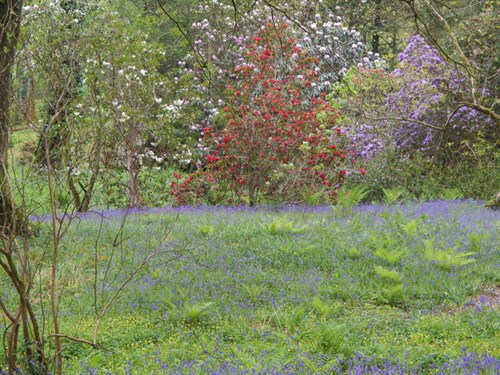
I am not a great fan of lilac even though it has a
tolerable scent in May. but the flowers of this form at Spetchley
Park were really attractivewith very generous flower
panicles
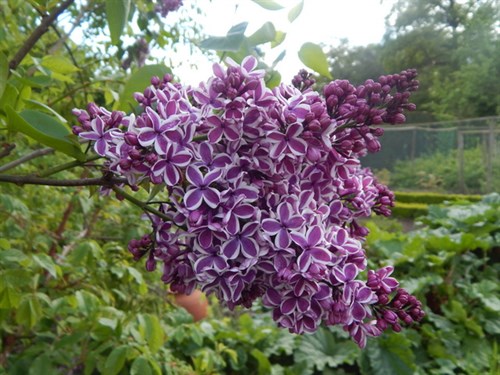
RHS Malvern Spring Festival on a dismal day. My
favourite view of the entire showground , smaller nurseries against
the background of the Malvern Hills, some of England's finest
scenery
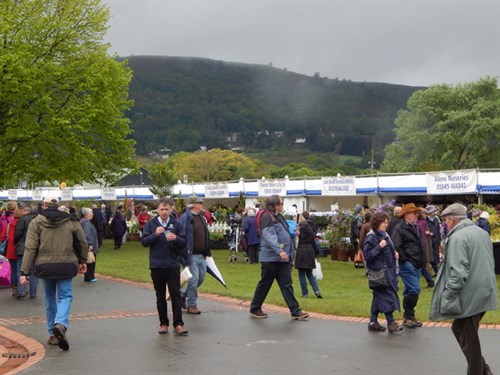
Back at Cilgwyn the superb lacecap hydrangea like
flowers of viburnum sargentii "Onondaga"
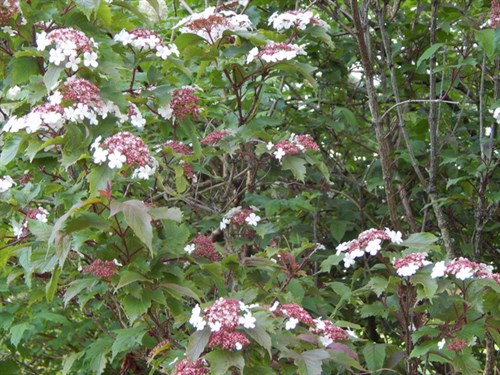
A seed grown clematis sown 2007 from wild collected seed
in Japan - all the world in a garden!
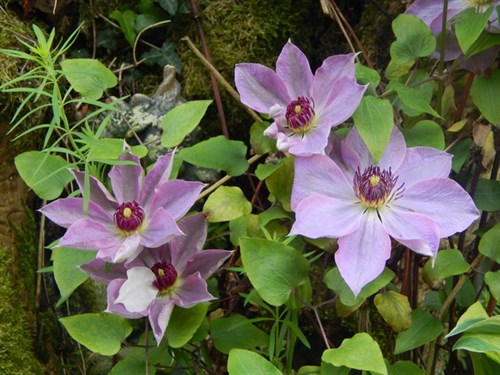
The view across the Paddock Pond now cleaned of
blanketweed with primula candalabra x in the
foreground
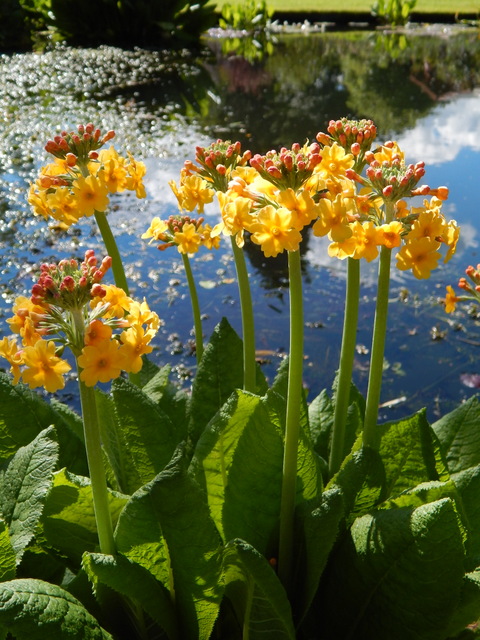
In the polytunnel the unusual flowers of a recent
introduction mathiasella bupleuroides "Green Dream" The flowers
turn to lilac as they fade. Likes some shade and is not fully
hardy.
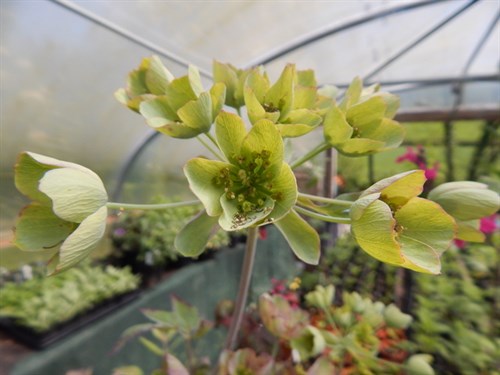
Weather
No frosts in May was an event to celebrate as I can't renember
the last time it happened. There were a couple of scares on 14th
and 15th May when the nightime temperature dropped to 2C and the
"snowmen" came out briefly (see March 2014 news for an explanation)
but other than this every other night was above 6C which ensured
that plants kept growing. On six days mid month, day time
temperatures exceeded 20C with a max of 23C on 16th. Some heavy
rain on and off and in the heat of mid month, a few thunderstorms
broke out. Winds generally light from the easterly or north
westerly quarter.
Lovely pink tinged clouds over the view to the north
from the Lodge with a fine stand of hedge parsley in the
foreground
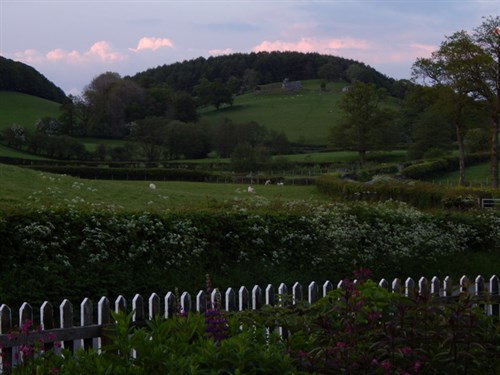
Garden Update
A really busy month with every area of the garden and nursery
demanding attention, plenty of watering to do in the nursery and
recent plantings in the gardens adding to the workload. Usually I
don't get in until 10pm after completing the watering. Thank
goodness for light evenings!
Whilst most areas are well ahead of normal, the vegetable garden
is struggling to catch up. Although the weather has been good it
has been difficult to work the soil because it has been very
slow to dry out sufficiently to sow seeds. Potatoes however are on
the move, carrots, beetroot and onions growing away and all early
brassicas planted. The first of the early summer cabbage "Hispi" is
heading nicely and early caulifower "Snowball"is looking
promising.
A good stand of brassicas sown under protection in
January, cabbage "Hispi" being the earliest and the first 2 were
cut tonight for evening meal

Small seeds direct sown in mid April are much
slower but at least the parsnips have had a full germination this
year
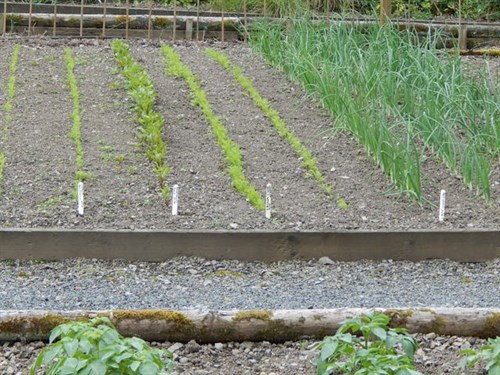
I have had mixed success with peas - "Hurst Green Shaft " is the
only variety I grow, sown at 2 week intervals from mid April
onwards at 4 different stations to give a long season of picking,
the last being late July/mid August. Mice as usual have been
challenging and the first sowing was badly affected with about 30%
devoured but mouse traps came to the rescue. The second sowing has
had a full germination with no predation.
As regular readers and garden visitors will know, I am very keen
on hardy annuals which I start off as plugs in early March to
harden off and plant outby late May in a number of the flower
borders and the wilder areas. The range grown this year has
includes white, yellow, purple and orange Californian poppies,
Shirley poppies, an improved form of the field poppy in a range of
tissue paper pastel coloured petals, cornflowers red and blue,
South African daisies dimorphotheca and ursinia, orlaya grandiflora
(a beautiful low growing umbellifer), nicotianas in variety and for
later in the season,rudbeckias and cleomes which complete the
annuals collection. Plugs are a more reliable way of placing them
where you want them, and planting out plugs straight from the trays
is much less labour intensiive. Next month it will be safe to
plant out all the tender perennials grown from cuttings last
autumn. More on these next month, but I should mention that because
of the mild winter and spring many of last years have successfully
overwintered for the first time including Salvia confertilfolia and
salvia"Hot Lips"
Rabbits have been the only downside and although they have done
relatively little damage so far, choosing to eat the "light and
airy" plants and leaving the luscious succulent leaves like hostas
well alone; from the droppings and one sighting, they are baby
rabbits and in time they will progress to the larger and more
choice plants in the garden. As a precaution, all the lettuce and
brassicas are covered with horticultural fleece, which is an added
bonus as it helps to retain moisture, creates a microclimate where
plants can grow more quicly and keeps bugs like carrot and cabbage
root fly at bay.
Finally flowering shrubs have been magnificent wth a succession
of viburnums followed by the native hawthorns which lose nothing in
comparison to the introduced ornamental shrubs. An added bonus is
that all the hydrangeas have overwintered well and the serratas and
macropetalas have advanced buds which should ensure that they
flower next month, the earliest flowering that we will
have ever had.
What's looking good?
For once, I am almost lost for words! There are so many plants
vying for inclusion that it is difficult to make the choice as
every day new candidates emerge. The main candidates however
include lovely lupins, aquilegias, poppies, hostas, iris and buds.
Buds? Yes BUDS!! Am I nuts? Make your own mind up from the pics
that follow.
Lupins are border stalwarts for early summer but
are at least 2 weeks early this year. They were the star plant for
me at the recent Chelsea Flower Show. These are up to 4 feet tall
scented and just 2 tears old from seed
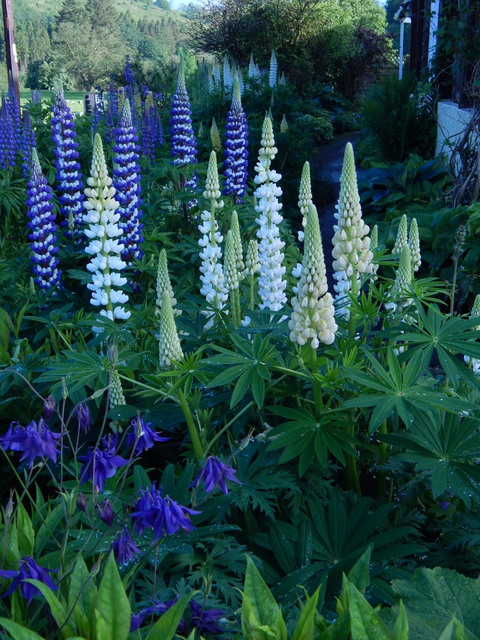
A more unusual lower growing but wide spreading
form of lupin Silver Cloak form Plantworld Seeds in Devon. In
the picture below it is paired with artemesia ludoviciana "Valerie
Finnis"


A few of the wide range of aquilegias grown
here
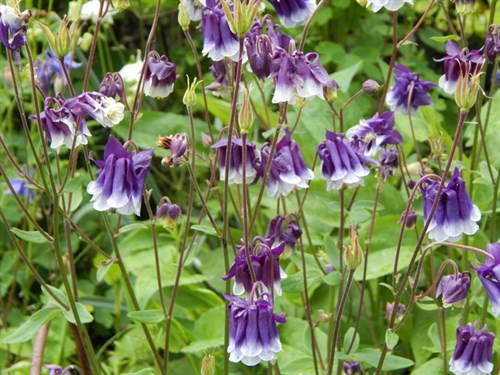
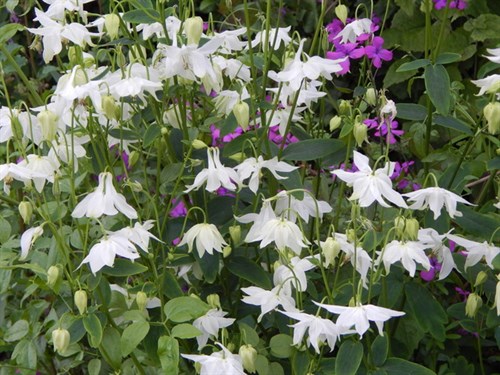
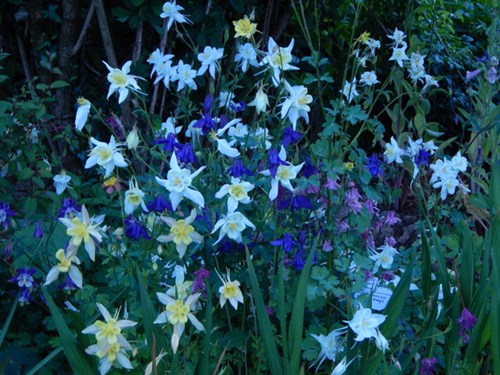
Poppies like everything else are very early and
this fine red orientalis is "Beauty of Livermere", 4 feet tall and
one of the best reds with no hint of orange.
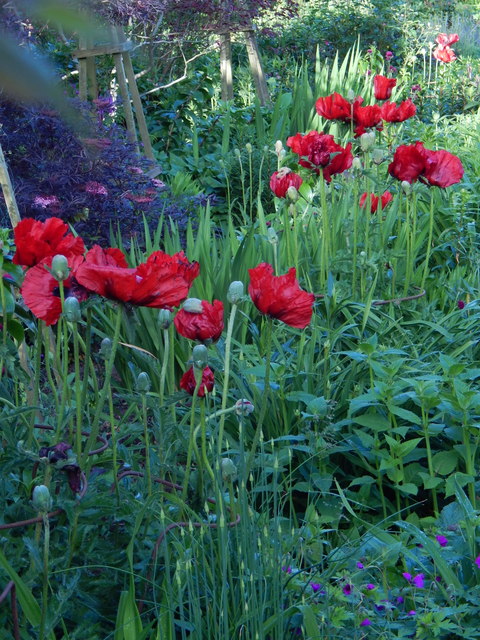
This one is orientalis "Allegro" with orange
folded tissue paper petals and the most marvellous dark blotched
centre forming a cross marking the spot for pollen crazy
insects

And finally the famed and fabulous Himalayan blue poppy,
this one being Fertile Blue Group Lingholm, which is reliably
perennial as long as you remove the flower buds in the first
flowering year, The picure does not do the intensity of the blue
colour justice and I am clearly not a sufficiently proficient
photographer to capture it!
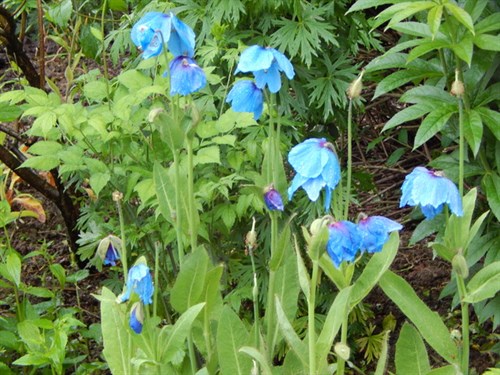
After a slow start hostas have been terrific. With over
200 varieties in the gardens they make a major statement
everywhere, none better than the more shady areas around the
Paddock Pond

One of the best for looking good over a long period is
"Night Before Christmas", one of the more normal names given to
hosta cultivars!

Astrantia "Abbey Road" the good reddish purple colour
showing up to better effect at twilight

All the iris have done well so far this year but none
more so than the sibiricas which in these long established clumps
have never flowered better. The first pic. is of "White Swirl", and
the other the lovely intense blue of "Silver Edge"
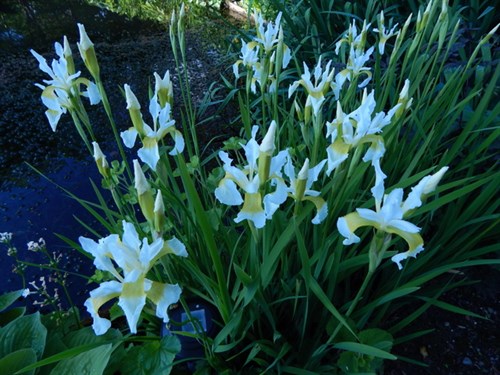
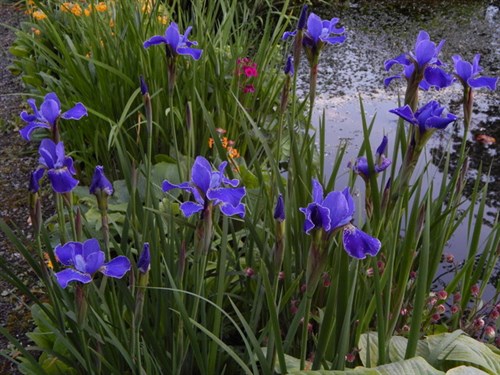
But of all the star performers none eclipses the mighty
cardioicrinum giganteum grown from seed sown in 2008. It is the
highlight of my horticultural life. There are 2 stands in the
garden with a total of 7 plants in bud. This pic taken today shows
the plant at over 5 feet tall and the cane is 7 feet. Do NOT miss
next months News Item when there may be some flowers to show
you
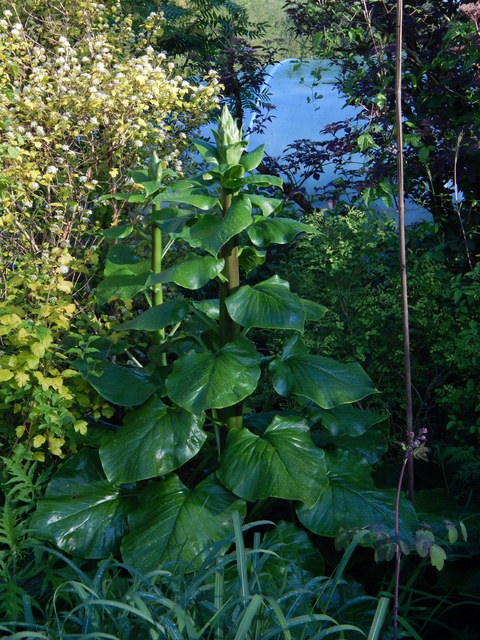
Now then -BUDS!! Just in case you think I have totally
lost it here is an explanation. I always try to get as much
satisfaction from every plant no matter how big or small. The
skeletal form in winter, the early leaf shape, and colour,
the form and habit of the plant in growth, the contribution it
makes to all its neighbours, the scent of leaf and flower,
the post flowering period - how long it takes to go past its best,
autumn colour and the value of its seedheads. But without doubt
other than the flowers themselves, the highlight is the bud stage
and all the promise and pleasure that lies locked within
them. There is such an infinite variety too. If poets such as
Shakespeare, Laurie Lee and Philip Larkin to name just a few
that come readily to mind on this subject, can see some beauty and
wider impact in them, why can't we?
Cardiocrinum rosette.
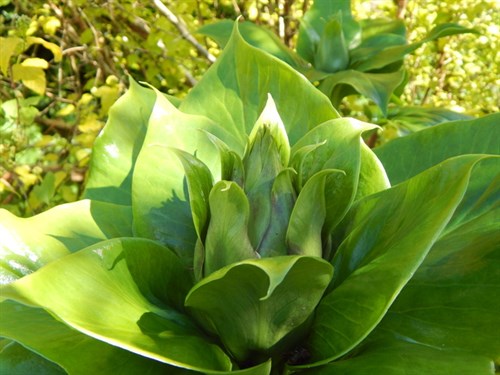
Delphinum spike showing colour in the bud

Lilium martagon album. Most lilies form their buds early
on and keep you waiting for that tantalising moment when they open.
In the case of martagons they flower usually in June

Lilium martagon hybrid "Orange Marmalade" a more upright
coloured bud on a plant that reaches 5 feet tall in
time

Long tight spiralled buds on iris sibirica "White
Swirl"
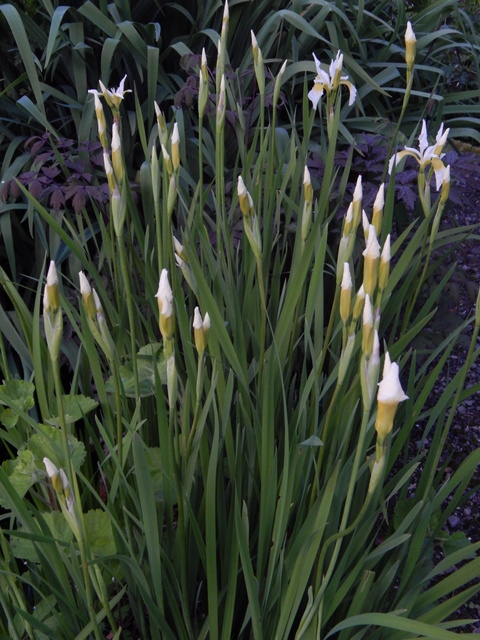
This intriguing spiralled bud in bronze and green
belongs to this tender justicia carnea hybrid with bicoloured
flowers
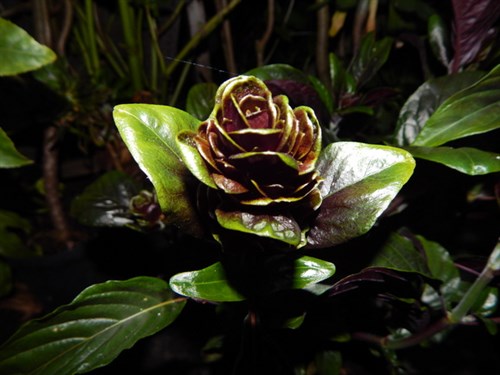
Buds of rodgersia pinnata opening to red
flowers
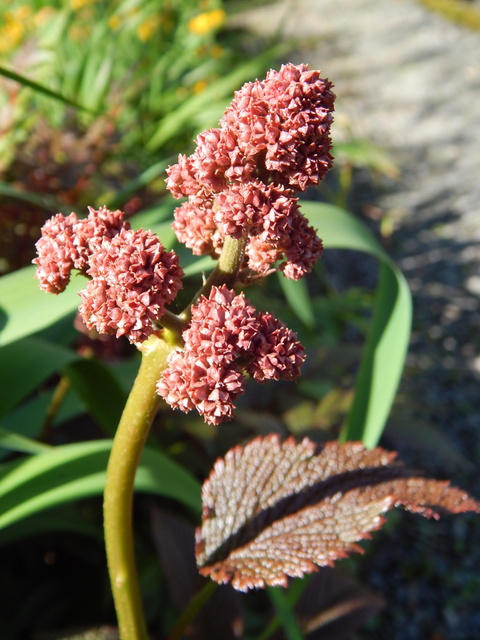
And finally this huge bud belongs to unbellifer
peucedanum verticillare and contains numerous separate flower heads
to 6 feet
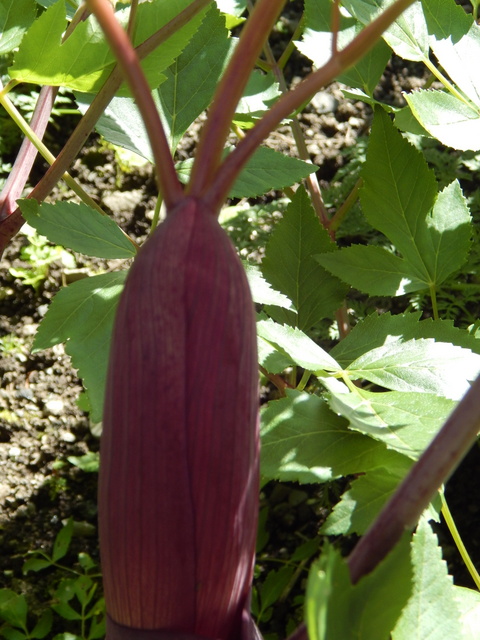
Wildlife and countryside
The pied flycatchers duly arrived on 1 May and started to
examine the nest boxes I had erected to replace those lost in the
winter gales which generations of flycatchers had used before .
Sadly they decided that they were not fit for purpose even though
they were recommended specifically for that breed and since then
they haven't been seen again.
Home for rent, Going cheep!!

Redstarts are in the valley but I have only had spasmodic
sightings and nothing nesting in hedgerows anywhere near us. Herons
are regular visitors to the Paddock Pond to feast on the tadpole
populations, which does at least distract them from the resident
shoals of rudd. A few days ago we had the unusual sighting of 2
greater black backed gulls flying over the gardens looking entirely
out of place, but menacingly large. No gales out at sea (about 35
miles away to the north and south) It is a mystery why they were
that far inland.
We had some good sightings of a ? a wheatear, for several days
last week, using the large woodpile as a vantage point to pick out
its prey. As it flew out you could hear the snapping of its bill as
it caught a wide range of flying insects including one mild night
when we had a rise of what looked like mayfly

Finally on the subject of birds I had the rather comical sight
of a tiny wren with a huge moth in its beak destined for a nest of
very noisy babies deep in the hedge at the top of the garden.
Native trees in common with garden plants have been very early
this year with oaks coming into full leaf by late April, Even
notoriously slow trees like alders and sweet chestnut are now in
good growth but ash trees of which there are plenty here are
conpicuous by their gaunt largely leafless presence in the fields
and hedgerows. Even at the end of May they are yet to come into
full leaf. It raises serious concerns for me that they may perhaps
be weakened by the early stages of the dreaded ash dieback disease.
I hope I am not being too pessimistic as the ash is the third most
common tree in the UK.
The bluebells have been fantastic but are now finished, and the
hedge parsley is smothering the roadside verges as are magnificient
stands of ox eye daisies mingling with tall meadow buttercups. It
is about now that local Councils decide it is time to cut back the
road verges!
Safe from council workmen these bliuebells are in the
garden of friends Anne and Philip, set off beutifully by an avenue
of silver birches

The lambs continue to entertain, none more so than a flock of
later born lambs in the Lodge Field opposite the house. Finding
ways out of the field seemed a good game for a time, 2 very young
ones deciding that the road on a blind bend was a nice warm
place to take a siesta! And as to the sole thistle plant in the
field no one has had the heart to cut it down as 2 lambs have
adopted it as a surrogate mother having decided that it is not very
nice to eat!!

Visits and visitors
Our first visitors of the year were Llinos and Eirian, a local
couple who had theit wedding photographs taken in the gardens on a
beautiful day. It is nice to be able to use the gardens in this way
on such a joyous occasion and to raise money for the NGS at the
same time. We have also had several other visitors since then
but our official opening date is 1 June so it is safe to say that
we are now open and if you would like to come to see how well the
garden looks please get in touch to make the arrangements
(see under Conact Details and Opening Times elsewhere on our
wesbsite).

The 1929 Rolls Royce which took the happy couple
to the reception
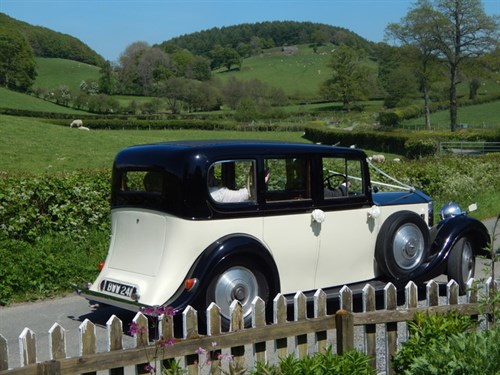
We have managed to find the time to go garden visiting ourselves
to make the most of the marvellous spring colours, which has
included Picton Castle (stunning woodland gardens), Malvern RHS
Spring Festival, Spetchley Park Gardens, Worcs., and Aberglasney
our nearest public garden with large stands of stunning cypripedium
orchids.
Malvern Sring Festival had a rather bizarre
display at the main entrance!
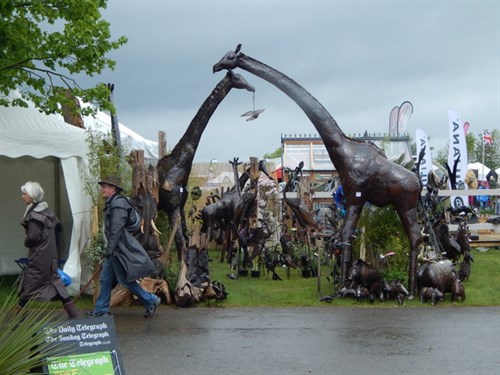
Even more bizarre was the sight of a Mediterranean show
garden with the background of the deeply rural Malvern
Hills!. In some ways however I guess it could be mistaken for a
Caribbean island.
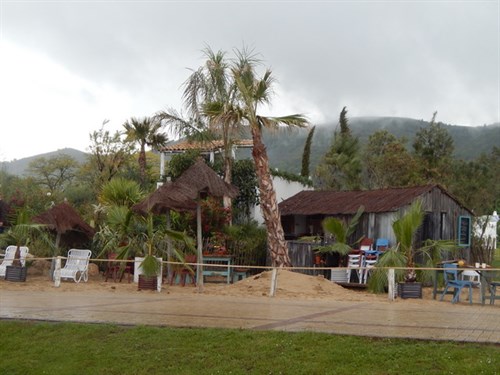
Back to things closer to my heart a superb stand of
pleiones in an incredible range of colours

A trip to a favourite nursery in Evesham was the perfect
opportunity to pay homage to local asparagus at perhaps this most
famous watering hole, the "Round of Gras" at Badsey where there is
a whole menu dedicated to this noble vegetable (and rounds of
asparagus on the bar to purchase)

A few miles down the road at Spetchley Park superb
peonies were everywhere in the gardens
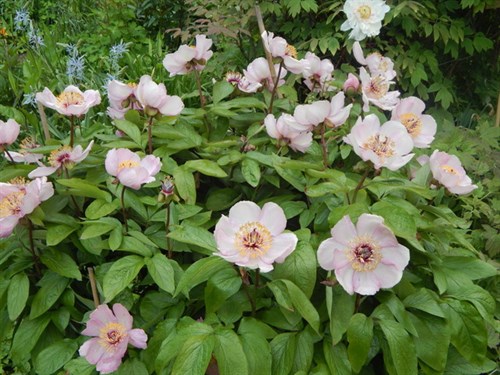
... and azaleas and other woodlanders
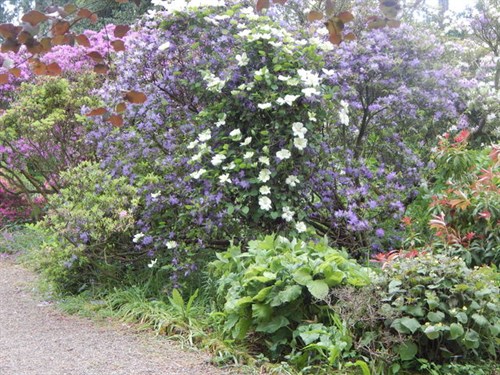
And finally where this long odessy began on 3 May,
Picton Castle with a winding stream bed lined with candelabra
primulas
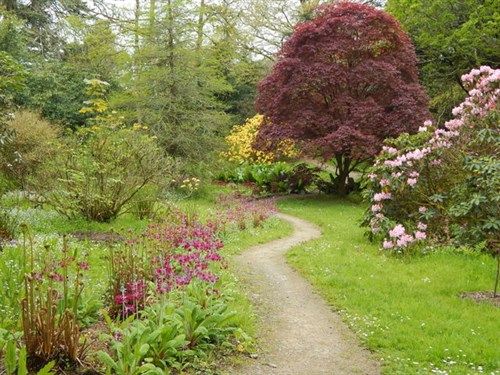
We also concluded our talks season on 27 May with a visit to The
Gardeners Club, Haverfordwest to give a talk on Hostas, which
doesn't get requested nearly enough. A large, enthusiastic and
highly knowledgeable audience was a delight to speak to and a great
way to end the season.